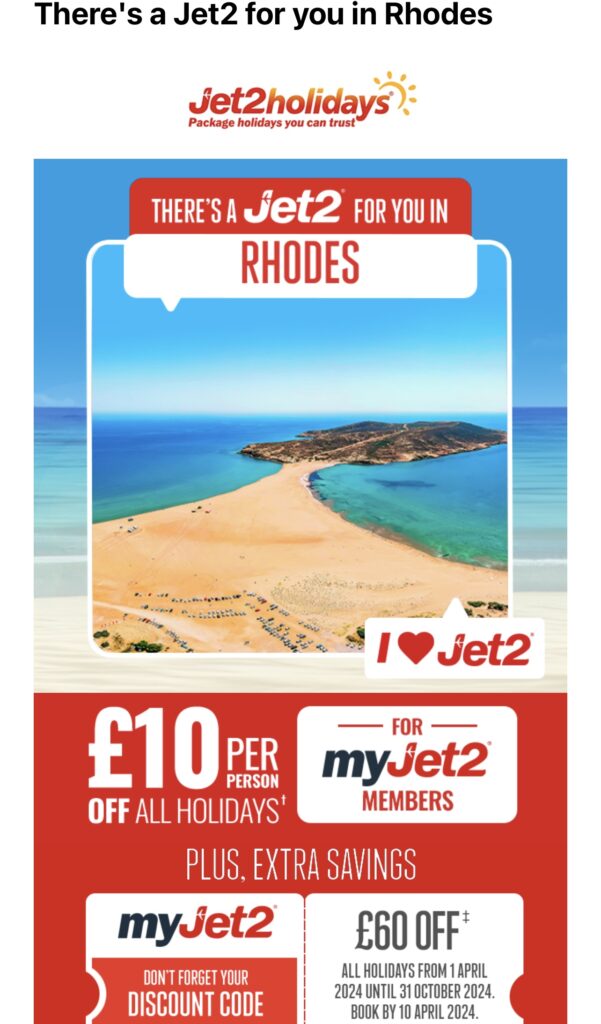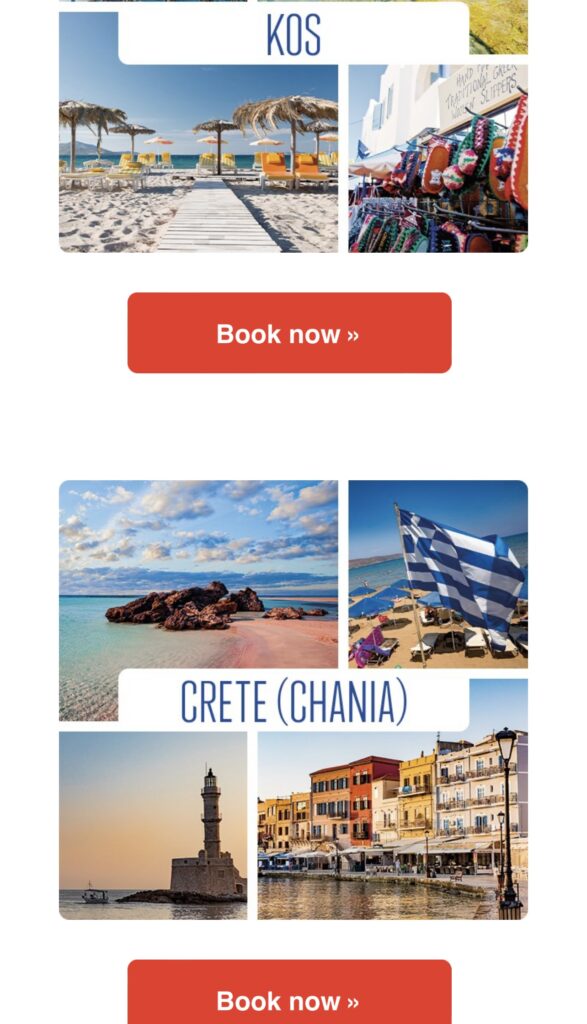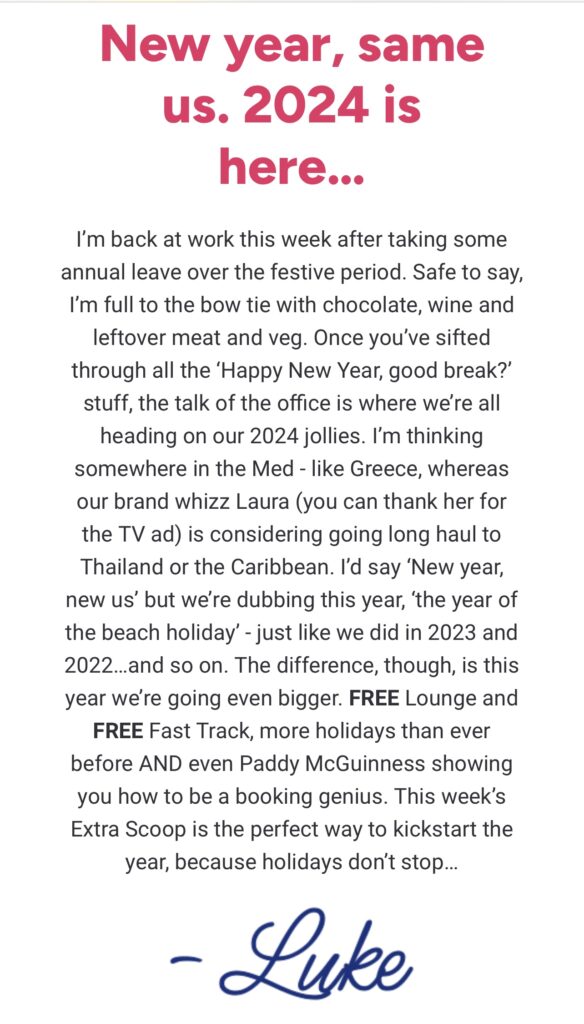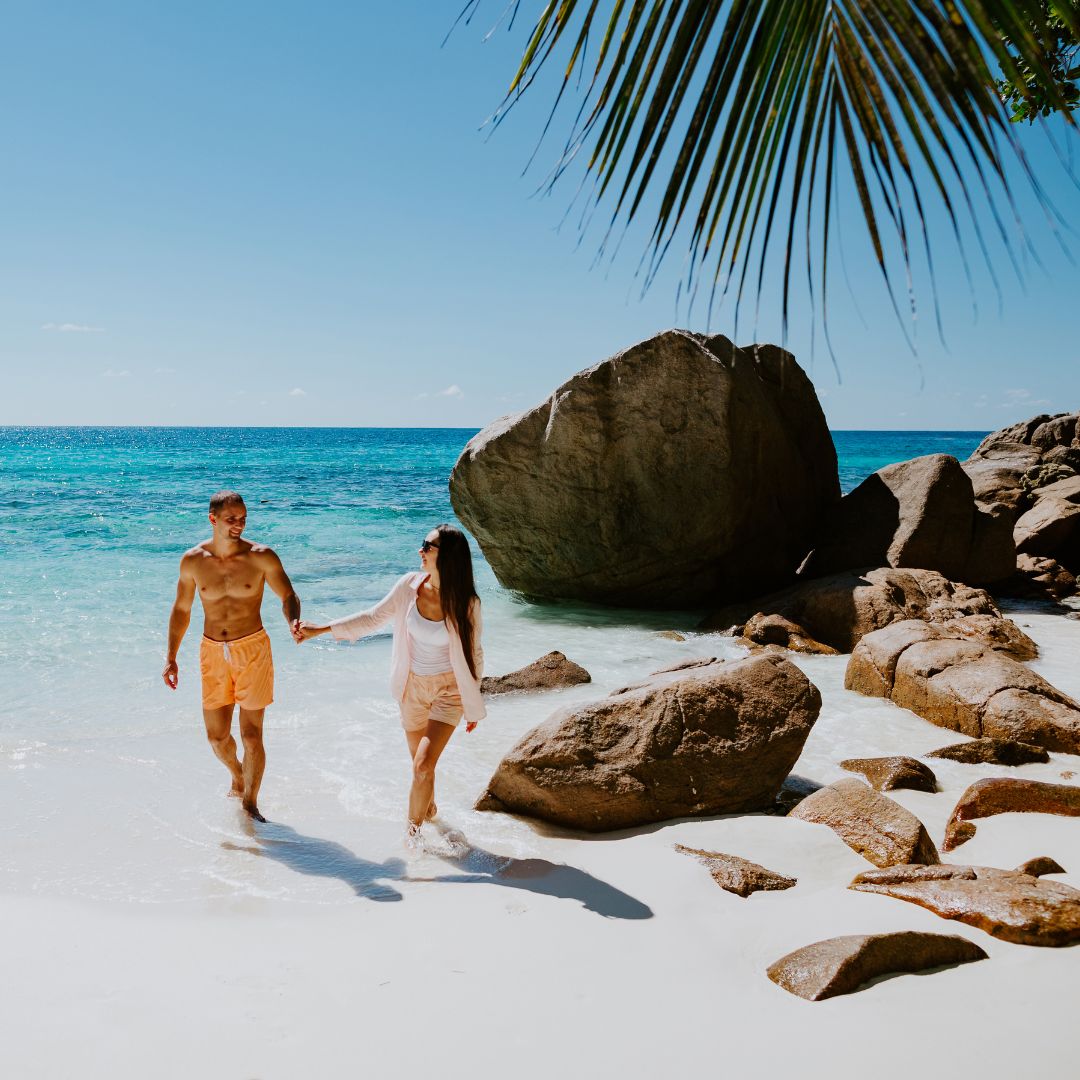Dull email content is today’s version of white noise for your loyal followers. Imagine pouring energy into campaigns that are virtually unseen and ignored. What’s the point?
There’s no need for concern. By embracing our three captivating travel email marketing ideas, you can ensure your communications capture attention and resonate with your audience.
Crafting hyper-personalised experiences and compelling narratives that evoke excitement for travel is the gateway to increasing engagement. With over 2.4 million emails sent globally every second, delivering content that piques curiosity and stands out from the crowd is essential.
Unveiling the 3 Engaging Travel Email Marketing Ideas
We have carefully picked three engaging travel email marketing ideas to keep your audience thirsting for more.
- The power of personalised content
- Seasonal promotions to surge engagement and open rates
- Tapping into the emotions of prospective travellers with storytelling
Idea 1: Personalised Content for Travel Email Marketing
There are several reasons why people may open an email. Did the subject line intrigue them? Was it an incentive that enticed them? Did timing have anything to do with it? These are all things in your control as a travel marketer or business owner. But what most people want to see is personalised content. That’s the key to engaging your audience with your email campaign. According to Sender, ‘71% of customers prefer tailored experiences, influencing their decision to engage with emails.’
It’s time that travel brands harnessed this and began creating compelling travel email marketing content. Think tailored suggestions or ideas derived from individual user preferences or behaviours. Imagine receiving an email suggesting an enriching culinary tour through the vibrant streets of Barcelona, Spain, showcasing authentic tapas, bars and bustling markets, all because you had previously expressed interest in Spanish cuisine and culture – that’s the power of personalisation.
How to Personalise
Basic information from user profiles, previous booking data, and browsing data can be utilised to provide tailored recommendations, updates, and travel inspiration. Previous booking data involves analysing the history of users’ bookings. By understanding where users have travelled in the past, the types of accommodations they’ve stayed in, and the activities they’ve participated in, travel brands can gain insights into their preferences and interests.
For example, if a user has previously booked a beach vacation in Hawaii, the brand might send them recommendations for similar beach destinations or updates on deals for Hawaiian accommodations. Similarly, if a user has been browsing hiking trails in the Swiss Alps, the brand could send them inspiration for hiking trips in other mountainous regions.
Personalisation allows travel brands to enhance the customer experience by delivering content that aligns with users’ interests, preferences, and past behaviours, ultimately increasing engagement and driving conversions.
Example:


Jet2’s email campaign is a prime example of personalised content in action. By leveraging data on the customer’s previous booking to Rhodes, Jet2 tailored their email to suggest a holiday in Rhodes again, offering a discount code to incentivise booking. This demonstrates an understanding of the customer’s preferences and behaviours, aligning with the concept of personalised content.
The email doesn’t stop at just suggesting Rhodes; it goes further by offering alternative destinations within Greece, acknowledging the customer’s potential broader interest in Greek holidays based on their past booking. This approach aligns perfectly with the idea of providing tailored suggestions or ideas derived from individual user preferences.
Idea 2: Seasonal Promotions in Travel Email Marketing
Seasonal promotions can rev up engagement and drive conversions in travel email marketing. These promotions capitalise on the timing of various seasons, holidays and national days to capture the attention of potential travellers and encourage them to book trips. Emailing exclusive offers for Valentine’s Day getaways, discounted summer vacations, or winter city breaks can catch the attention of individuals planning their annual leave or spontaneous trips.
Valentine’s Day getaways cater to couples looking for romantic destinations to celebrate the holiday. Discounted summer vacations target individuals and families planning their summer holidays and seeking affordable travel options. Winter city breaks appeal to travellers interested in exploring urban destinations during the colder months.
Travel brands can stimulate engagement and drive conversions by incorporating promotions into seasonal events in their email marketing campaigns. These promotions create a sense of urgency and exclusivity, encouraging recipients to take advantage of the limited-time offers. Additionally, they tap into the anticipation and excitement surrounding holidays and seasonal activities, making them more appealing to potential travellers.
Example:


Take a look at this example from On the Beach. The New Year is a prime time for travel planning as individuals often start thinking about their upcoming holidays and trips. On the Beach is capitalising on this planning mindset by sending this email during the New Year period. While the email doesn’t explicitly mention a specific holiday or season, it offers discounts and perks relevant to travel planning during a time when the ‘new year, new me’ mindset starts. The free lounge and fast-track access are appealing to all travellers. It also creates a sense of urgency and exclusivity by offering a 20% discount on EasyJet flights, which implies that the offer is limited and recipients need to act quickly to take advantage of the savings. This aligns with leveraging limited-time offers to drive engagement and conversions.
Overall, seasonal promotions in travel email marketing serve as practical tools for attracting customers, increasing bookings, and generating revenue. Especially when strategically timed and tailored to the target audience’s preferences.
Timeliness is Key
A crucial element of seasonal promotions is the timing. Timeliness ensures the offer’s relevance, which can help reel in prospective travellers.
For instance, offering discounted ski resort packages in the autumn when travellers are starting to plan their winter holidays increases the likelihood of engagement and conversions. Similarly, promoting beach getaways in the spring as people begin to anticipate summer holidays can capitalise on the timing of travel planning.
Idea 3: Storytelling in Travel Email Marketing
Travel is all about experience, emotions, and memories. Storytelling taps into these elements, making it one of the most compelling ways to engage audiences. Captivating tales about destinations rich in culture and adventure can inspire readers to start planning their next trip.
Here are 5 ways to start storytelling in your email marketing campaigns:
- Create Personal Connections: Share authentic stories and testimonials from real travellers to create a sense of authenticity and relatability. Highlighting personal experiences fosters trust and encourages readers to envision themselves experiencing similar adventures.
- Set the Scene: Paint a vivid picture of the destination by describing its unique sights, sounds, smells, and tastes. Use descriptive language to evoke sensory experiences and transport readers to the destination in their imagination.
- Focus on Emotions: Appeal to readers’ emotions by highlighting the transformative power of travel. Emphasise the joy, excitement, wonder, and fulfilment of exploring new places and immersing oneself in different cultures.
- Highlight Unique Experiences: Showcase the destination’s unique attractions, activities, and experiences that set it apart. Highlighting off-the-beaten-path adventures or hidden gems can pique readers’ curiosity and inspire them to explore beyond the typical tourist attractions.
- Offer Practical Tips and Advice: Provide valuable information and practical tips related to travel planning, such as insider recommendations, packing advice, or local customs. Offering actionable advice enhances the utility of the email and positions the brand as a trusted resource for travel expertise.
Impactful Storytelling:
Authentic and impactful stories give your readers a glimpse into what could be their experience. Shrinking down an alluring adventure or an enchanting cultural event into a 200-word narrative can trigger imagination and launch readers into a virtual vacation, making them more likely to book the real deal.
Hummingbird’s Example of a travel email

The above mock-up travel email of a hypothetical travel agency called ‘Odyssey Travel’ is an excellent way of using storytelling in email content. The email creates personal connections with the quotes from Sophia and Nikos, sets the scene with descriptive language throughout, and creates excitement and anticipation overall. Of course, this would accompany good-quality visuals.
How to Implement These Engaging Travel Email Marketing Ideas
- Practical strategies for understanding your audience
- Planning seasonal promotions for maximised impact
- Creative approaches to crafting your travel brand’s story
Understanding Your Audience
No high-performing strategy can outperform without the bedrock of audience understanding. It’s like a compass pointing in the direction of revenues. But how do we go about this?
Application of Data Analytics
Broadly, your audience comprises a diverse set of individuals sharing common interests. Data analytics comes in handy here. A look into your website or email analytics reveals patterns and preferences amongst your followers. Do they love adventurous vacations? Beach vacations? This understanding feeds directly into your email content creation strategy. Keep in mind that customer privacy should be put first.
It’s crucial to prioritise customer privacy throughout this process. Take steps to ensure compliance with data privacy laws and regulations, and always obtain proper user consent before tracking or utilising personal data.
Directly Surveying Your Audience
Sometimes, direct communication with your users offers impactful insights. A simple email survey asking for their vacation preferences or feedback can provide concentrated insights.
Best Practices for Effective Surveys:
- Keep it concise and focused: Avoid overwhelming users with lengthy surveys. Keep questions clear, concise, and relevant to maximise response rates.
- Offer incentives: Consider offering incentives, such as discounts or entry into a prize draw, to encourage participation and increase response rates.
- Respect user privacy: Communicate how survey data will be used and ensure compliance with relevant privacy laws and regulations.
- Act on feedback: Demonstrate that you value user input by taking action based on survey findings. Communicate any changes or improvements resulting from feedback to reinforce trust and engagement.
Planning Your Seasonal Promotions
Seasonal promotions play a vital role for travel brands. The dynamism it brings can engage users deeply. A survey conducted by Digital Commerce 360 suggests that ‘62% of survey respondents said they’re most likely to open promotion-driven emails.’ That says it all!
Early-Bird Discounts
Who doesn’t like discounts? Launching ‘early-bird’ promotional emails can nudge users to act early and commit. This has dual benefits: your revenues get a boost, and users feel happy with a good deal!
Early-bird discounts are a classic marketing tactic that leverages the psychological principle of urgency and scarcity. By offering exclusive discounts to early bookers, travel brands can incentivise users to make their travel plans sooner rather than later. This not only helps boost revenues by securing bookings in advance but also creates a sense of satisfaction among users who feel they’ve scored a great deal.
Key Points to Consider:
- Timing: Launch early-bird promotions well in advance of the travel season to give users ample time to plan and book their trips.
- Clear Messaging: Communicate early booking benefits, such as discounted rates or guaranteed availability, to encourage users to take advantage of the offer.
- Limited Availability: Emphasise the limited availability of early-bird discounts to create a sense of urgency and prompt users to act quickly.
- Segmentation: Target early-bird promotions to specific audience segments likely to respond positively, such as repeat customers or subscribers who have shown interest in similar offers in the past.
Unique Seasonal Themes
Each season and festival presents a unique opportunity for travel brands to align their promotional efforts with the prevailing mood and themes. By incorporating seasonal themes into your marketing content, you can more effectively capture your audience’s attention and create resonance with your target demographic.
Key Points to Consider:
- Research: Identify the key seasonal themes and festivals relevant to your target audience and major markets.
- Creativity: Brainstorm creative ways to incorporate seasonal themes into your promotional content, such as themed travel packages, destination recommendations, or seasonal activities.
- Localisation: Tailor seasonal themes and messaging to resonate with the cultural preferences of your audience in different geographic regions.
- Consistency: Maintain consistency in branding and messaging while adapting to seasonal themes to ensure a cohesive and engaging user experience.
Crafting Your Brand’s Story
Your brand isn’t just a name; It’s a story! It’s more than just a name or a logo; it’s a narrative that resonates with your audience and forms the foundation of your identity and values.
Emotional Connections
Stories are powerful tools for forging emotional connections. When crafting your brand’s story, focus on communicating your values, mission, and vision in a way that resonates with your audience’s emotions and aspirations. This could involve sharing personal anecdotes, testimonials, or examples of how your brand has made a positive impact on people’s lives. Be genuine and authentic—nothing resonates better!
Meeting Customer Aspirations
Share inspirational customer stories featuring their experiences. This validates your offerings and positions your brand as the facilitator of incredible travel stories. An aspirational brand picture can significantly boost your user engagement.
Key Points to Consider:
- Authenticity: Ensure your brand’s story is genuine and authentic, reflecting its core values and beliefs. Avoid embellishments or exaggerations that could undermine trust and credibility.
- Consistency: Maintain consistency in your brand storytelling across different channels and touchpoints to reinforce your brand’s identity and message. This includes your website, social media profiles, email communications, and advertising campaigns.
- Engagement: Encourage audience engagement by inviting them to share their stories and experiences related to your brand. This could involve user-generated content campaigns, social media contests, or interactive storytelling initiatives.
Remember, these strategies are all interconnected. Better audience understanding feeds into more impactful promotions and storytelling and vice versa. Plan. Implement. Analyse. Iterate. That’s the name of the game!
Conclusion
Our inboxes are inundated with mundane messages; standing out is the ultimate goal for any travel brand.
With the three travel email marketing ideas mentioned in this blog, you’ll have your audience booking flights instantly!
First, personalised content – like a bespoke suit, tailored to individual preferences. Then, seasonal promotions – think Christmas morning, but with exclusive deals in your inbox. And lastly, storytelling – because who doesn’t love a good tale?
So there you have it – three surefire ways to optimise your travel email marketing strategy and keep your audience coming back for more.
Bon voyage!
Click here to find out more about our travel marketing services.



